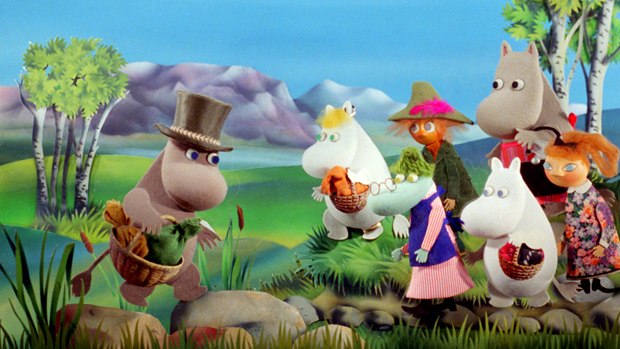Read about this Finnish stop-motion feature's unique 3-D conversion.
Check out the Moomins trailer!
The Moomins are back -- and in 3-D. That's right: thanks to the latest digital advancements and the clamor for everything stereoscopic, Tove Jansson's big, white, fuzzy, whimsical trolls, which have taken Scandinavia and Japan by storm, are now primed for the big screen.
Moomins and the Comet Chase, produced by Tom Carpelan's Oy Filmkompaniet Alpha in Finland, premieres tonight at the Cannes Film Festival in 3-D (a Nordic first) with voice work by such Scandi stalwarts as Mads Mikkelsen, Max von Sydow, Helena Mattsson and the father-and-son team of Stellan and Alexander Skarsgard. Plus Moomins fan Bjork has written "The Comet Song," with an animated music video forthcoming.
However, the interesting thing about The Comet Chase is that it's actually a clever repurposing of the beloved '70s stop-motion series, which was a Polish/Austrian co-production with animation by award-winning Se-me-For Studios.
Carpelan, who had been eyeing Scandinavian distribution rights of the series for 20 years but was thwarted by copyright snafus until 2007, saw a great theatrical opportunity by re-cutting, restoring and converting into a stereoscopic feature.
"It's an odd idea to take a series from the '70s," Carpelan admits, "and so we made a test, like a pilot film (Moomin and Midsummer Madness), which was a theatrical success in 2008. But then I got the idea of doing it stereoscopically before it became so hot. I felt that stereo was the whole intention of how the series was made originally. It was a very complicated stop-motion production, done in layers with the fuzzy felt puppets separated from the other animated objects (painted on glass plates in the foreground and background. The whole idea was to create some form of three-dimensionality even if stereoscopic wasn't technically possible back then."
According to the producer, the project now contains brand new stop-motion for the opening and closing credits (artist Antonia Ringbom) as well as minor CG enhancements by Undo Finland. The full digital restoration was done by Labfilm in Poland. The extensive 2-D to 3-D stereoscopic conversion, meanwhile, was produced by Stereoscape in Finland and QXD Japan in co-operation with Aalto University Helsinki and Waseda University Tokyo.
"Technically, there were restoration challenges because the original film elements were in bad condition, but also because of the layered process," Carpelan continues. "When the series was originally filmed, lighting was a problem because of the double glass layers casting bothersome shadows. We had to remove the shadows and did all kinds of tests so you wouldn't notice the refilling where the shadows were before. That was quite a task to make it look like the original animation."
The stereoscopic work was just as intensive: "QXD has a program that automatically analyzes the depth charts of the film but then you have to manually do a lot of work as well," the producer explains. "And the characters have fuzzy felt with lots of hair and you had to be really careful when you did the masking. It has worked well and has been quite a handicraft."
According to Stereoscape producer Ilkka Peltola, this project has been a marriage of nostalgia and cutting edge technology. Working closely with director Maria Lindberg and Carpelan, Stereoscape tried to find the right balance between an immersive experience and a family-friendly comfort level.
"The conversion process is called 'Hybrid Off-line 2-D to 3-D,'" Peltola explains. "This way, we have a great balance on cost-efficiency compared to some other conversions. Basically, the conversion contains a few phases. First of all, the source material (2-D images) is analyzed and the staff prepares for the conversion by reviewing the original material and its depth cues. Our conversion staff is highly experienced and consists of people from both technical and artistic backgrounds. So, there are people who have PhDs and there are professional painters as sort of a counterbalance. Both types of 3-D artists are vital in our conversion flow, as they bring their own points and pragmatics to the table.
"We've used depth maps as the basis of our conversion. Through these different phases, we've carried out quality checks on which several people participate and go through a series of enhancement discussions relating to theoretical and practical aspects in the use of stereoscopy and, technical view and artistic feeling of the spatial design. For example, how to locate different objects in space, how to express depth by interpreting the 2-D image and coinciding with the story's emotion, how to maintain depth consistency…"
Another challenge was making the stereoscopic experience enjoyable for young children (who apparently experience the third dimension more drastically). "We have been emphasizing the quality and responsibility in the use of stereoscopy," Peltola continues. "Thus, we've made the stereoscopic movie to be more suitable for everyone to watch. We've done some qualitative tests for the use of depth with Moomins and it has had an important role in confirming our expectations. I think that the type of content, audience and main purpose for the use of 3D decide very much on what kind of a role stereoscopy should have and how it would be utilized as a filmmaking tool."
Carpelan adds, however, that they are not finished with final stereoscopic work: "We will not try to approach the same kind of depth as in Alice in Wonderland or any of these other movies because we want this film to be seen by a much younger audience. So we are now testing and balancing the final depth and will most likely increase it a little from the version we are now showing in Cannes."
Bill Desowitz is senior editor of AWN & VFXWorld.











